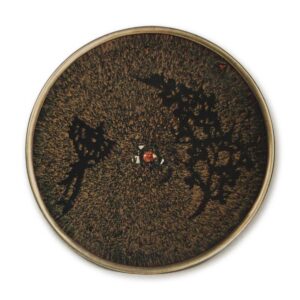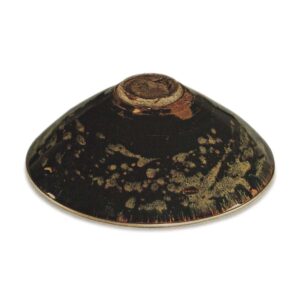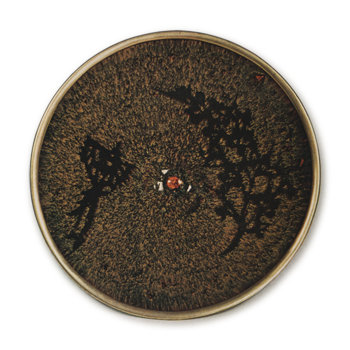

Height: 5.1 to 5.2 cm
Diameter: 15.1 to 15.2 cm
Outer diameter of foot ring: 3.5 to 3.6 cm
Height of foot ring: 0.3 cm
This is a tea bowl with a lid that was passed down through the Maeda family, the feudal lords of Kaga. This is a slightly large flat bowl with a wide interior, and the design is a vivid one, with a long-tailed bird-like Asuka pattern and branches with small flowers in opposition. This folded branch pattern also looks like the tips of some trees swaying in the wind, and it blends well with the long-tailed birds flying lightly. The overglaze is a slightly thick sandy glaze that shines with a dull sheen.
The foot ring is the small, rough-looking style unique to the Kishu kilns, but the foot ring is sharply and crisply cut, and only the foot ring is unglazed, revealing the hard, tightly-fired, yellowish-white, rough clay surface. As usual, the glaze is applied in two layers, with a seaweed-like ash glaze called “white bush clover” or “straw white” applied over the black glaze on the inside and outside to create the pattern. The outside is simply sprinkled with splashes, while the inside is cut into a black pattern using a paper stencil. It seems that the bamboo that grows in abundance in the area around Ji’an is the source of the material for this type of ash glaze. Even so, the subtle melting of the ash glaze is wonderful, and the effect of the deep, vivid jet-black patterns emerging from the beautiful, sea cucumber-like mixture of blue, yellow and red is truly nothing short of amazing. The gray glaze is probably blown on from above the mold, but the important thing is that the pattern is not drawn by hand, but is based on a paper stencil.
Paper cutouts are a folk craft with a long tradition in China, and have been popular since the Tang dynasty, but only the Jizhou kilns of the Song dynasty were able to achieve such results by applying this technique to ceramics.
Since the founding of the People’s Republic of China, many good materials excavated from the Jizhou kiln site have been introduced, and there are still many interesting examples of this type of tea caddy made from cut paper. However, the fact that there are still outstanding works that have been handed down in our country is the same as with the Jian ware tenmoku.
What is also wonderful about this tea bowl is the accompanying net bag. The beautiful red cord is woven into a large and small hexagonal pattern to make the net bag, and the cord is tied in a way that is called hyoshoku, which means that the color scheme is good. The tea bowl is wrapped in this, and it also becomes a gorgeous decoration. We cannot help but admire the excellent design of the tea masters of old.
The accompanying items include a box made of paulownia wood with a Shunkei lacquer finish, a gold-leaf lettering design on the lid, and a box made of paulownia wood with a gold-leaf lettering design on the lid.
It is said to have been passed down through the Maeda family of Kaga, but nothing is known about its history before that. It is currently in the collection of a certain family in Kyoto.



